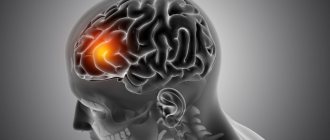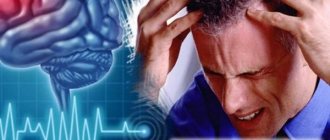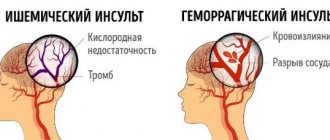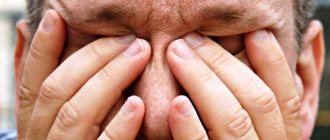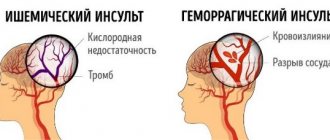In this article we will try to figure out whether it is possible to fly on an airplane after a stroke and what the consequences are.
No one is immune from diseases in this world; some of them can seriously threaten human life. For example, stroke has the second position on the list of deadly diseases. What kind of pathology is this and how is it dangerous for the patient?
A stroke is a circulatory disorder that causes cells in the brain to die, resulting in either death or varying degrees of disability.
Stroke: main causes
Is it possible to fly on an airplane after a stroke? We’ll figure it out below. In the meantime, let’s find out what causes the disease.
The main reason for this dangerous pathology is that one of the brain vessels is blocked by blood clots or foreign objects. Blood cannot get through this barrier; as a result, acute oxygen starvation occurs, and some of the cells die. This phenomenon is called “ischemic stroke”. It is better to find out in advance whether it is possible to fly after such a pathology.
A hemorrhagic stroke is when an artery ruptures and blood spills into the outer tissue of the brain, causing swelling that causes the death of cells and nerve fibers.
- Surgery
- Oncology
- Neurosurgery
- Radiology and Radiation Therapy
- Gynecology and new reproductive technologies
- Traumatology and Orthopedics
- Cardiology
- Neurology
- Laser surgery
- Urology, andrology and microsurgery
- Plastic surgery
- Mammalogy
- Lithotripsy
- Psychological support service
- ECO
- Weight loss
- Pressure chamber
- Endovascular surgery
- Encephalopathy
- Stroke
- Rehabilitation after stroke and TBI
A stroke is an emergency!
Symptoms that should make you suspect something is wrong and urgently seek help:
- sudden weakness in an arm and/or leg;
- sudden numbness in the arm and/or leg;
- sudden disturbance of speech and/or understanding;
- sudden loss of balance, loss of coordination, dizziness;
- sudden loss of consciousness;
- acute headache without any apparent reason or after severe stress or physical strain;
- sudden numbness of the lip or half of the face, often with a “distortion” of the face.
If you, your relative or friend experience at least one of the first symptoms of a stroke, immediately call an ambulance. Describe exactly what happened to the dispatcher so that a specialized neurological team can arrive. And know that in this case every minute counts!
The most effective treatment is possible in the first 3 hours (maximum 6 hours) from the moment of cerebrovascular accident. This is the so-called therapeutic window, when it is still possible to avoid the development of irreversible changes in the brain.
After you have called an ambulance, before the doctor arrives, do the following:
- Place the patient on high pillows so that the head is elevated above the bed level by about 30 degrees;
- Open a window or window to allow fresh air into the room;
- Remove tight clothing, unbutton your shirt collar, tight belt or waistband;
- Measure your blood pressure;
- If it is elevated, give the drug that the patient usually takes in such cases;
- If there is no medicine at hand, immerse the patient's feet in moderately hot water;
- At the first signs of vomiting, turn the patient's head to the side so that vomit does not enter the respiratory tract, and place a tray under the lower jaw. Try to clear the vomit from your mouth as thoroughly as possible.
Patients with acute stroke should be hospitalized in a hospital that has 24-hour tomography or magnetic resonance imaging . Only with its help is it possible to definitively clarify the diagnosis, and, consequently, carry out adequate treatment.
Depending on the mechanism of development of acute vascular pathology of the brain, several types of stroke are distinguished: Most often (up to 80% of all cases), the disease develops as a result of an acute disruption of blood flow to a certain area of the brain (the so-called ischemic stroke or cerebral infarction). If it is possible to diagnose ischemia in time and carry out thrombolysis (drug dissolution of a blood clot), then it will be possible to save the patient’s life and return him to a full life. If brain pathology is caused by blood soaking a part of the brain, then this is a hemorrhagic stroke, or intracerebral hematoma (about 10% of all cases). In this case, the patient requires hospitalization in the neurointensive care unit. In some cases, patients with acute stroke require neurosurgical craniotomy to relieve brain swelling.
The main thing is timely help
This disease is very dangerous for human health; half of the cases are fatal. But if you provide the patient with medical care in time, his life can be saved. After a stroke has occurred, the patient must be placed in the intensive care unit within 3-4 hours, in some cases an operation by a neurosurgeon will be required. The less time it takes to get to the hospital, the higher the chances that the person will remain alive and will not become disabled. However, the area of the affected area of the brain is important: serious complications cannot be avoided if it is large.
What is the algorithm for preventing stroke?
Let's try to imagine a stroke prevention scheme for a middle-aged person.
- A prerequisite is a healthy diet, giving up bad habits, maintaining normal body weight and daily physical activity.
- Examination for susceptibility to atherosclerosis: taking into account heredity, blood test for lipid profile, ultrasound of brachiocephalic arteries with assessment of the thickness of the “intima-media complex” (an expert method for early diagnosis of atherosclerosis). If elevated levels of “bad” cholesterol and signs of atherosclerosis of the carotid arteries are detected, discuss with your doctor the issue of prescribing drugs that lower cholesterol levels.
- Daily (Holter) monitoring of ECG and blood pressure to identify “hidden” hypertension and possible heart rhythm disturbances that threaten cardioembolic complications. It is recommended not to allow periodic increases in blood pressure above 130/80 mmHg. Art. If rhythm disturbances are detected, additionally perform cardiac ultrasound (EchoCG).
- MRI of the brain with X-ray contrast agent to identify possible aneurysms of the cerebral arteries. If they are detected, it is possible to perform low-traumatic endovascular clipping of aneurysms or open surgery.
If you still have questions, you can contact a cardiologist or neurologist online in the Doctis application.
Long rehabilitation
Even with a successful operation, the patient will undergo rehabilitation for a long time. Most people after a stroke learn to live again and deal with the negative consequences of the disease. On average, a patient’s normal life can begin only after 2 months. It takes much longer to return to work; Driving a car or business trips to other cities and countries are unavailable to many for a very long time.
Patients who have suffered a stroke in the recent past, whose life was completely or partially associated with travel, ask doctors the question: “Is it possible to fly on an airplane after a stroke?”
What should you expect when you return home?
When you are discharged from the rehabilitation center, you will be given a discharge summary. It will cover all the necessary guidelines for caring for you at home, as well as the necessary equipment and supplies you may need. Returning home can be initially scary. You may not fully recover and will need to continue rehabilitation on an outpatient basis. You may also have many questions about how you can continue living a full life after a stroke.
Will flights be allowed?
As a rule, the doctor's answer will be positive. You can use air transport, but there are certain conditions and restrictions. This is important to remember. The problem is that, in fact, flying is a tiring and difficult process even for a healthy person.
Due to severe changes in pressure, stress and panic, and an unfavorable atmosphere in the aircraft cabin, repeated cerebral hemorrhage may occur, which will be fatal for most patients. What is especially scary is that qualified assistance will not be provided, because it is impossible to do this at altitude.
Driving
A stroke can affect your ability to drive safely in a variety of ways, such as your physical condition, visual impairment, or difficulty concentrating for long periods of time. In the first months, even after a mini-stroke, you are not allowed to drive. After some months, you will need to visit your doctor, who will give you advice and recommendations regarding driving and will tell you whether you can start driving again. They will likely refer you to have your driving abilities reassessed. It is important to tell your insurance company that you have had a stroke.
What points should be taken into account?
So, what is the opinion of doctors about whether it is possible to fly after a stroke? Typically, attending physicians allow such travel if the following points are taken into account:
- How much time has passed. If more than six months have passed since the operation, but not less than 2 months. It is a big plus if no health-threatening complications arise during this period. That is, after complete recovery from a stroke, you can fly.
- Quality of rehabilitation. The recovery period for the patient was completed successfully, massage and physical exercises were used.
- At what level is your blood pressure? It should be normal, without a sharp rise and fall, the threshold of 140/90 should not be exceeded. Regular intake of prescribed medications is important.
- Is the patient susceptible to aerophobia? Is it possible to fly after a brain stroke if you have a fear of flying? It is extremely important that a person does not suffer from aerophobia, as it provokes severe anxiety and stress.
If all conditions are met and the patient has confidence in his abilities, then he is allowed to fly and is prescribed certain recommendations.
When can you fly after a heart attack?
The answer to this question directly depends on the rehabilitation period that the doctor has determined for you. If you followed all the recommendations and successfully completed the course, then in the absence of complications and other circumstances, you will be allowed to fly. The recovery period depends on the type of illness suffered, the extent of the affected area, the causes of the pathology, stenting operations undergone, etc. To give an approximate idea of how long it takes to fly, below are approximate rehabilitation periods for some cases:
- Small focal myocardial infarction – 2 weeks.
- Large focal myocardial infarction – 6 months.
- Stroke – at least 2 months, on average – 6 months under favorable circumstances.
- Vascular stenting surgery – 2 weeks.
Important! The data provided is for informational purposes only. Your doctor will tell you the exact timing.
Even after rehabilitation, there is no need to rush to fly by plane unless absolutely necessary. The more time has passed since the illness, the better. Remember that it is your life, not just your health, that is at stake. Cardiovascular diseases are very insidious, a relapse can occur at any time, and without qualified help a person’s life cannot be saved.
The preparation must be correct
We continue to figure out whether it is possible to fly after a stroke. In advance, the patient must prepare himself and his blood vessels for high load.
The preparation process includes:
- Taking certain medications. Most often, doctors prescribe special blood-thinning medications (aspirin is considered the most popular) that prevent blood clots in blood vessels and relapse of the pathology.
- Passing examinations. Before the flight, an electrocardiogram and ultrasound examination of the vessels of the head are required. This is required to eliminate the possibility of aneurysm formation. During the flight, pressure changes are possible, and an aneurysm may rupture, leading to a fatal brain hemorrhage on an airplane after a stroke.
- Own first aid kit. The patient must plan in advance what medications he will take with him on the plane. The first aid kit should consist of medications that stabilize blood pressure and sedatives; medications against motion sickness are also useful.
If the preparation is carried out correctly by the patient, then it is possible to fly after a stroke.
Also, the trip will be comfortable if you purchase special pillows for the head, in this way the unnecessary load on the cervical spine and blood vessels will be reduced. Excessively fatty foods are contraindicated before a flight; it is better to prefer light foods.
Symptoms worsen at altitude
At altitude, the typical symptoms of hypertension worsen:
- The occurrence of migraine is a cerebrovascular disease due to prolonged spasm of blood vessels in the head. A dangerous complication is the cerebral form of hypertension (stroke). To prevent arterial hypertension from developing into a malignant form, it is worth defeating migraine at the initial stage.
- The appearance of pressing chest pain. The heart works overtime, so discomfort in the chest may turn out to be angina. If there is a history of myocardial ischemia in hypertensive patients, they should fly with great caution.
- Having severe shortness of breath. Limited space and elevation lead to a feeling of lack of oxygen; reflex shortness of breath may occur in response to stress. To avoid real suffocation, the patient’s breathing must be deep and even; oxygen cocktails can come to the rescue.
- Development of tachycardia. The intense work of blood vessels leads to a rapid heartbeat, because they quickly pump large amounts of blood. This leads to spasm of blood vessels and tension in their walls.
What are the dangers of flying after a stroke?
However, during the flight, the patient may in any case encounter various kinds of problems that cannot be foreseen in advance.
So, the problems could be the following:
- Dry air. The skin dries quickly due to air conditioning on airplanes, and the unpleasant thing is that the body quickly becomes dehydrated. But this provokes thickening of blood in the vessels, which can turn into a mortal danger for a person after a stroke.
Therefore, you need to drink more fluids, but not tea and coffee, but pure water, and still. Alcoholic drinks are strictly prohibited; their influence is detrimental to the cardiovascular system, and as a result, a heart attack can occur.
Long sitting position
Passengers on the plane remain motionless for a long time. Physical inactivity can cause blood clots, resulting in a recurrent stroke. This possibility will be higher the longer the flight lasts. Flights typically last more than five hours, so passengers often experience swollen feet.
Wearing compression garments under regular clothing will help prevent this. Women can buy special compression tights. They will disperse the blood where it stagnates. Sometimes it is acceptable to get up from your seat at least once and walk around the salon, of course, when this is not prohibited. To disperse blood throughout the body, it is good to rotate your hands, feet and neck. In general, simple health-improving exercises will help.
Turbulence
An unpleasant vibration appears when the plane hits air pockets. Under its influence, the heart rhythm may be disrupted, as well as blood circulation and blood supply to the brain. A new blood clot forms, and subsequently another stroke.
The only advice in this case would be the following. You need to calm down and try to sleep. If you follow all the doctors' recommendations, nothing bad should happen, especially if throughout the flight the patient kept his blood pressure under control, consumed enough fluids and stretched his legs. The trip will be comfortable and without serious consequences. How to fly by plane after a stroke?
What factors lead to stroke?
Risk factors often “work” for several decades before a stroke. Long-term causes of stroke are bad habits, and above all smoking, alcohol abuse, unhealthy diet with a predominance of animal fats and easily digestible carbohydrates (fast food, cola, pork kebab and mayonnaise), physical inactivity, and obesity. Diabetes mellitus, especially type 2, which in our time is becoming an epidemic, makes a big contribution.
A separate story is hypertension.
WHO recently lowered the blood pressure threshold from 140/90 mmHg. Art. up to 130/80 mm Hg. Art.
An episodic increase in blood pressure above these figures requires observation by a cardiologist and the beginning of systematic blood pressure monitoring, non-drug, and possibly medicinal treatment methods.
